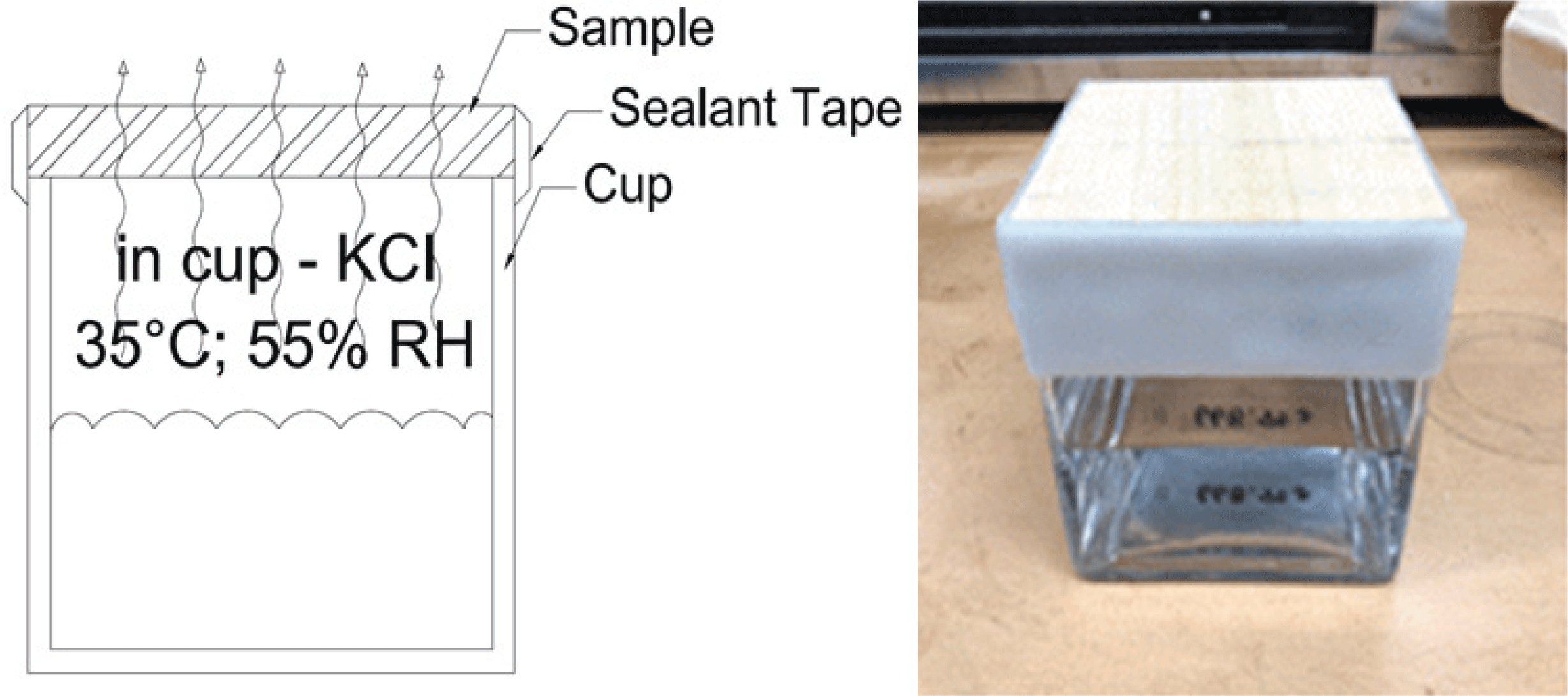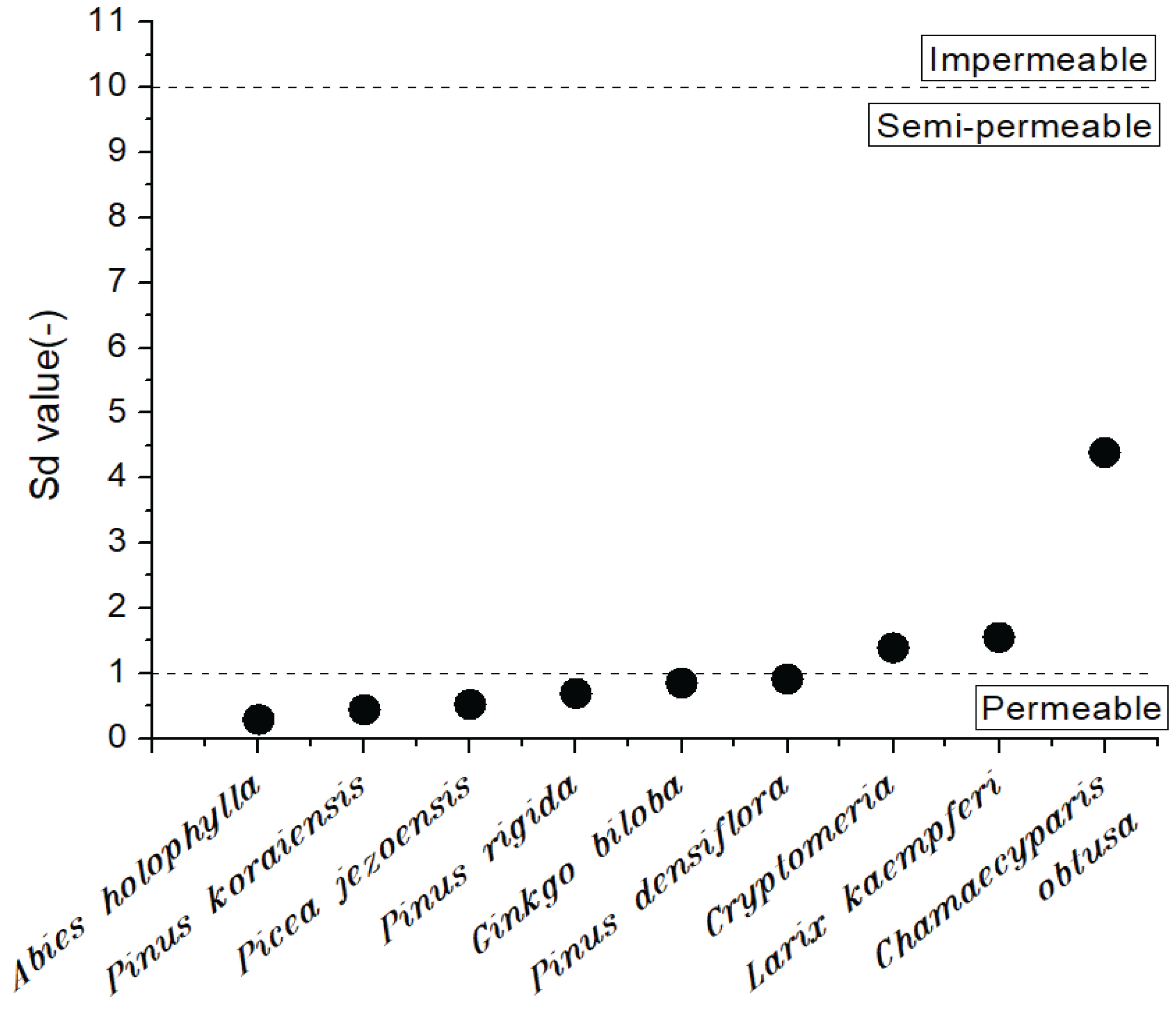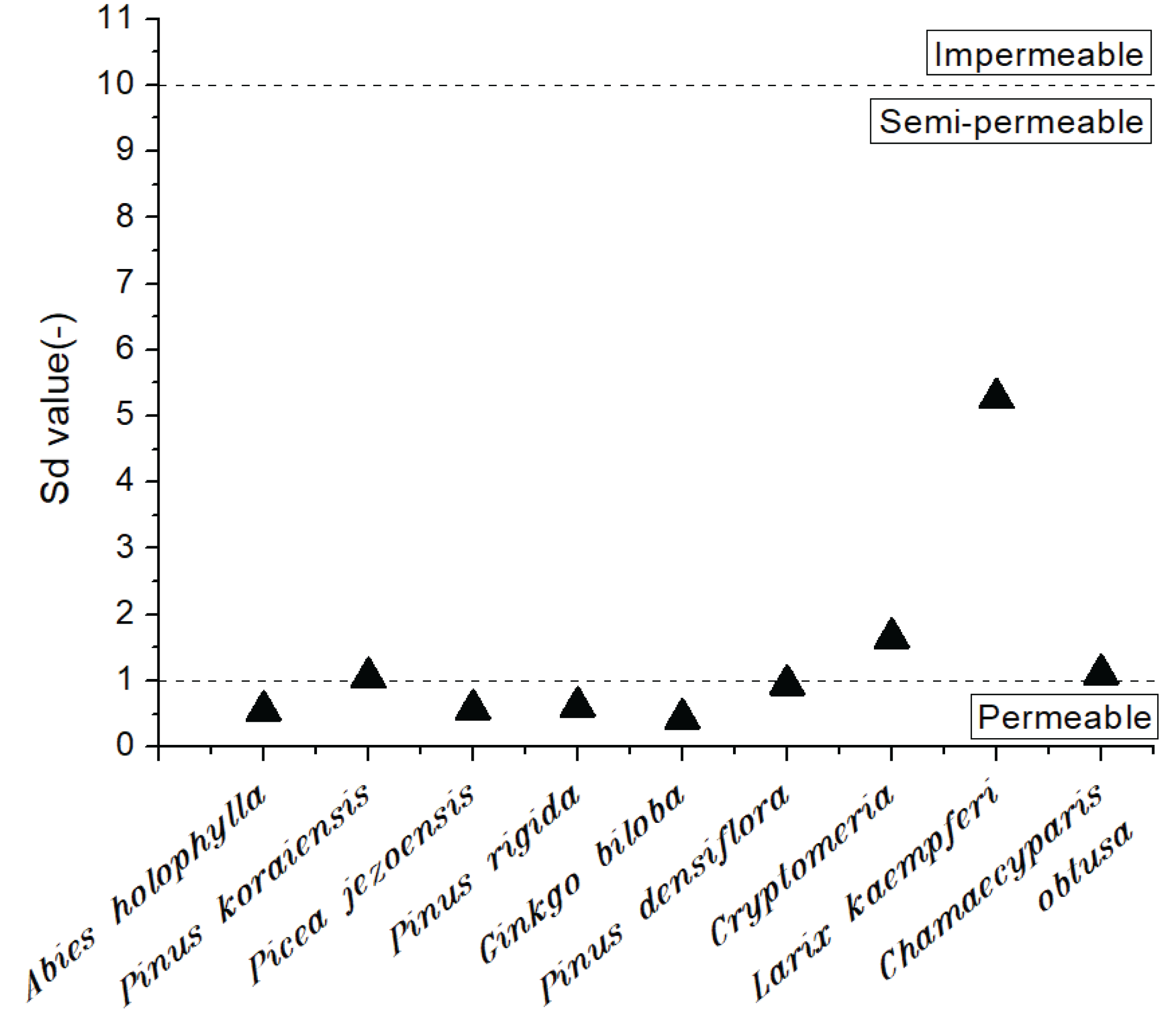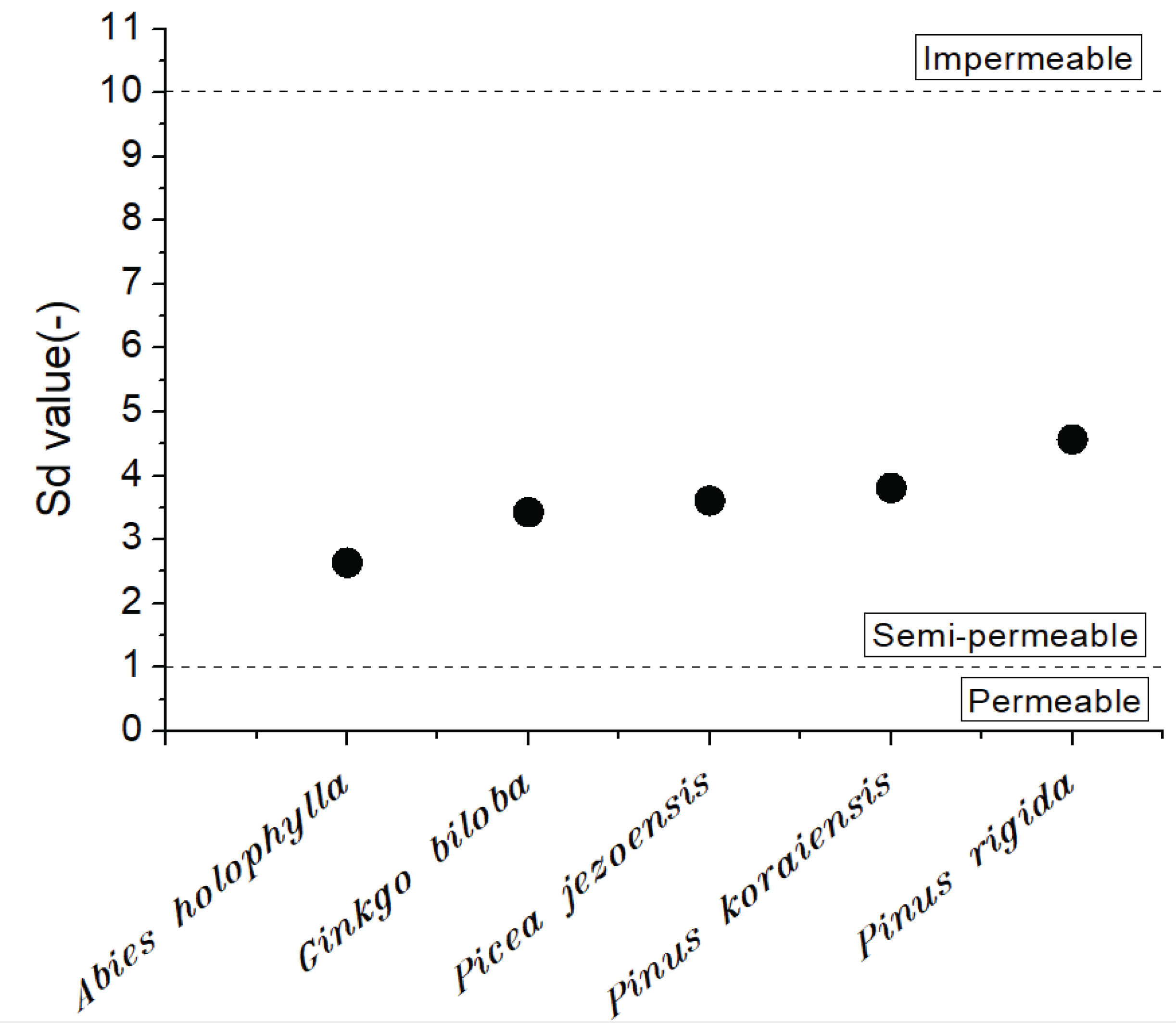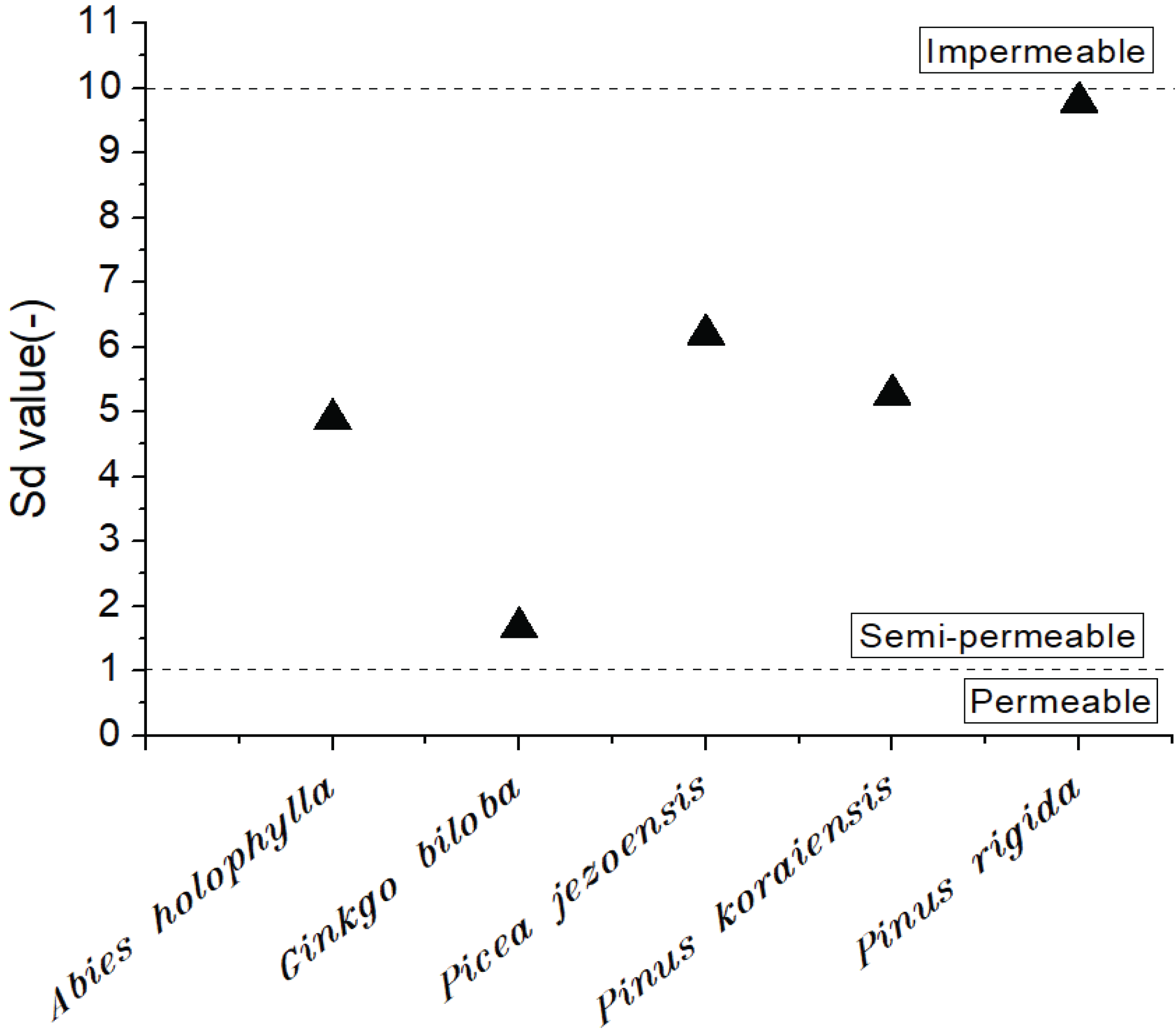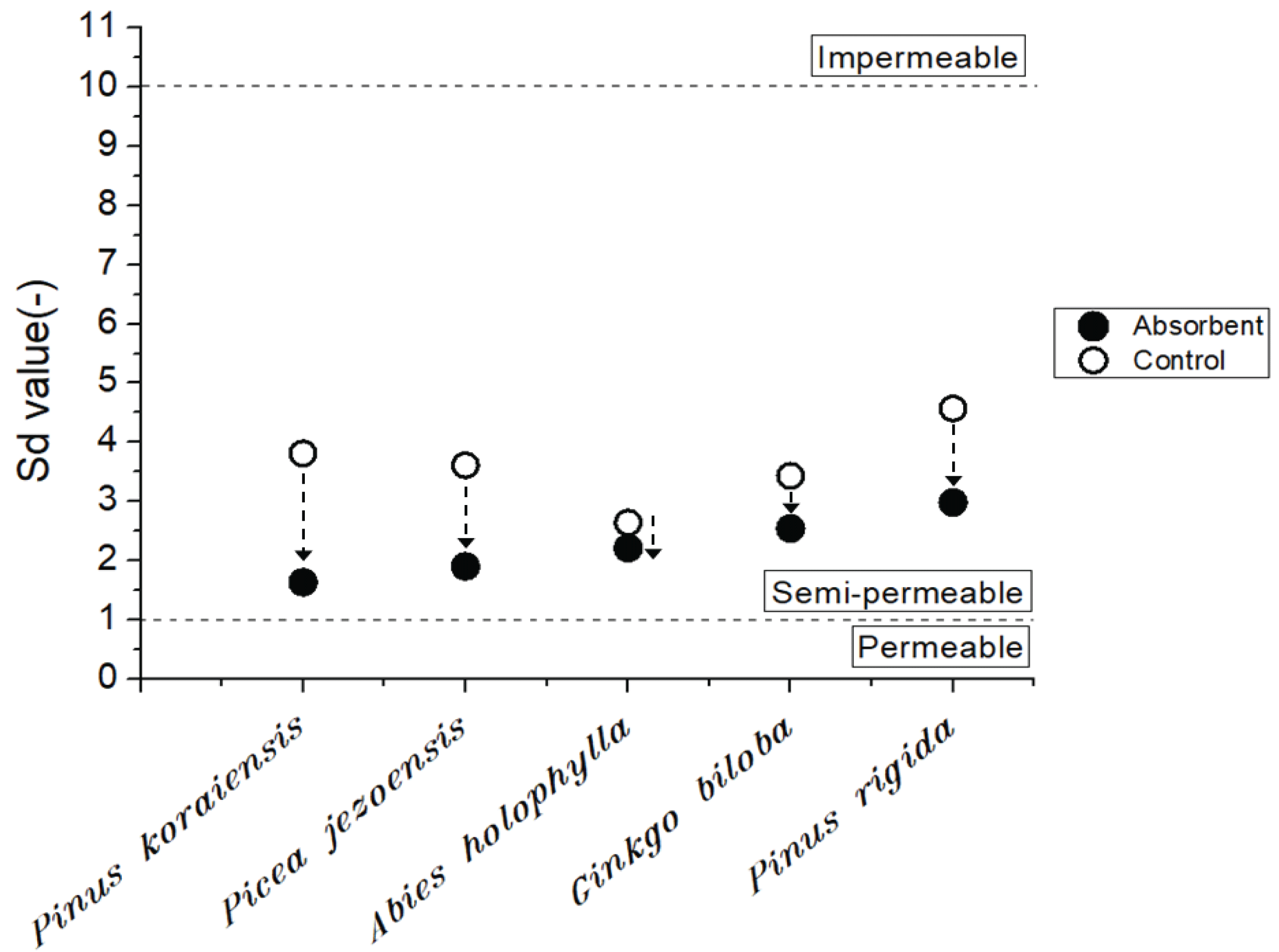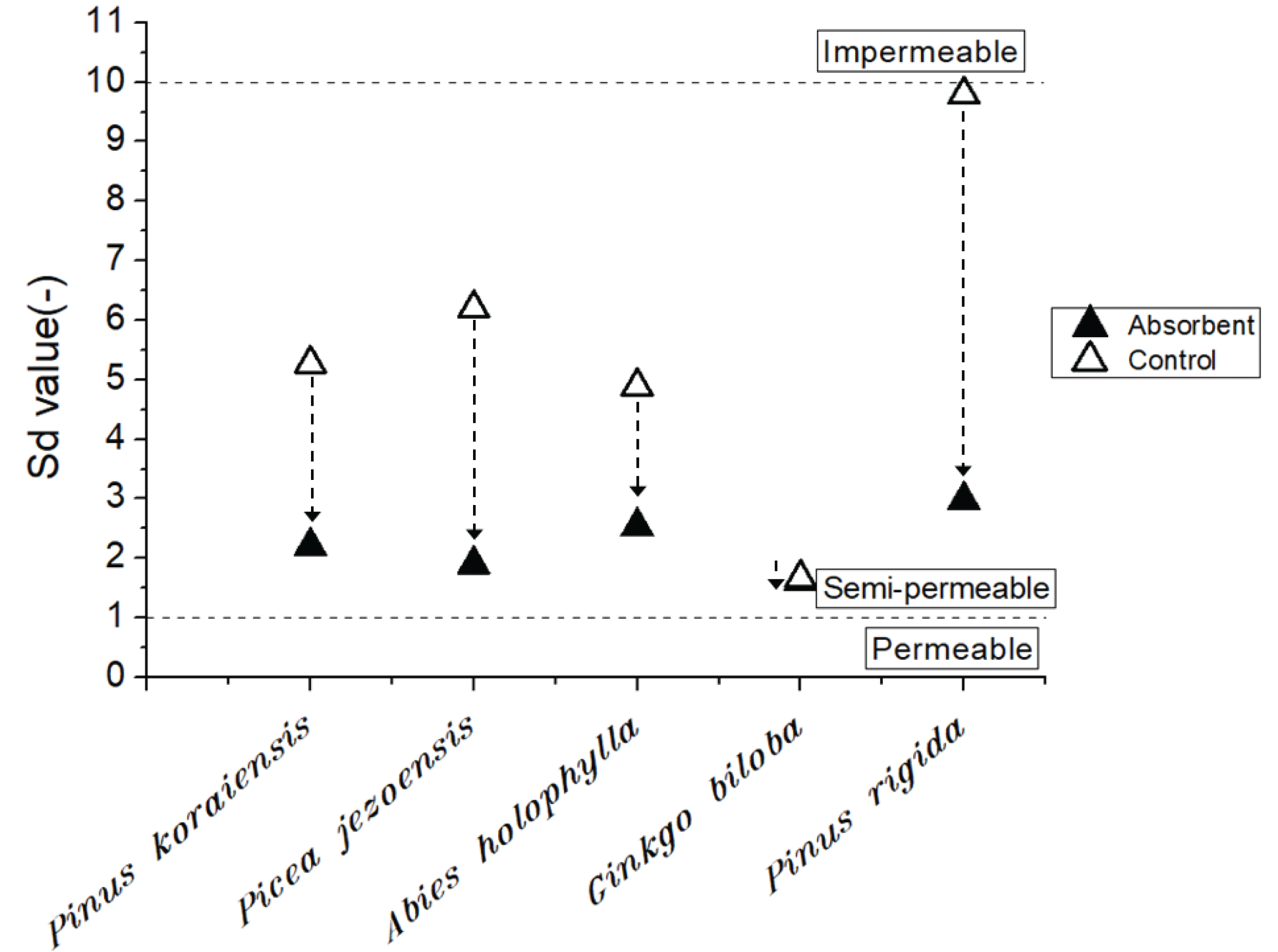1. INTRODUCTION
Indoor air quality is deteriorated by harmful chemicals such as formaldehyde and volatile organic compounds (VOCs) emitted from indoor building materials and household goods (Kim et al., 2011). Harmful chemicals released indoor are not enough to threaten the lives of indoor residents who spend most of their day, but long-term lifestyles have many effects on health, such as decreased immunity (Yoo et al., 2011). As interest in indoor air quality hazardous substances and interest in eco-friendly materials increase, the case of interior design using wood, which is a natural material has increased (Park et al., 2015).
Wood is a material excellent in humidity control, heat insulation, electrical resistance, sound insulation, impact resistance, and abrasion resistance, and provides a comfortable interior by controlling the temperature and humidity of the room (Kim et al., 2004; Lee et al., 2014; Yang et al., 2020; Yang et al., 2020). Among the characteristics of wood, heat insulation and humidity control are related to anatomical characteristics such as micropores and pit of wood. The moisture movement through the micropores caused by the differences of humidity conditions and water vapor pressure is defined as wood vapor permeability (Lim et al., 2006). Moisture permeability can be controlled indoor humidity due to the difference in water vapor pressure by moisture absorption in the high water vapor pressure and dehumidification in the low water vapor pressure (Lee, 1996).
However, the moisture permeability of wood differs depending on the species, density, sapwood and core, and the shape of the pitting, and the moisture permeability differs in the order of three sections of wood: cross section, radial section, and tangential section (Siau, 1984).
In particular, the flow of material is more advantageous in softwoods than in hardwoods, and more advantageous between the bordered pit of the axial trachied in tangential direction. It depends on the capillary structure of the axial trachied and pit structure in axial direction and the ray parenchyma help the horizontal flow. Air flow in the tangential direction is about 130 times less than the axial flow (Petty, 1970; Flynn, 1995). Radial direction liquid penetration is moved by the ray parenchyma and connected to the conduit rayvessel tissue inter-wall to facilitate the radial direction of the liquid movement (Chun, 2017).
Recent government policy has increased interest in wooden buildings with low thermal conductivity compared to other architectural materials due to the strengthening of the thermal perfusion rate of buildings. In particular, the wooden structure is constructed with a waterproof paper that makes it possible to prevent the penetration of moisture inside and outside the structure member wood and control humidity. As the construction case of high-rise wooden buildings has increased using a large wood panel, Cross Laminated Timber, the study of the permeability, permeability resistance evaluation and wall configuration for moisture has been conducted (Yoo et al., 2019; Jang et al., 2017). In order to improve the residential environment of the wooden building made of wood as porous material, moisture permeability is evaluated using moisture permeance, permeability rate, vapor resistance, and etc (Lee, 1992).
In addition, Bio Dryer Co., Ltd. in Japan, to minimize drying defects that occur during forced drying, a bio-dryer (Fig. 1) consisting of a wall made of wood is being developed and sold. The principle of the bio-dryer assumes that the dryer is a single large cell, and moisture transfers from the green wood put in the dryer to the outside so that it can be dried to less than 10% without drying defects of the wood. Mostly, tree species such as hard maple, which is difficult to dry, such as wood for repair of cultural properties and musical instruments, are dried at 35°C for 1 month to produce less than 8% dry wood (bio-drywood, 2018). However, in the domestic situation, studies on the use of broadleaf trees are being conducted as the accumulation of broadleaf trees in the country increases, but due to drying defects such as torsion and internal splitting during forced drying of hardwood, the sawn yield of oyster oak is as low as 30-40% (Jang et al., 2017).
In this study, in order to localize the bio dryer used in Japan, the evaluation of the moisture permeability of domestic softwood was conducted. In addition, in order to promote the movement of moisture generated in the wood drying process to the outside and improve the moisture permeability, the evaluation of the moisture permeability of a small wall filled with bottom ash, which is a coal ash emitted after coal combustion in a thermal power plant, was conducted. Through this, it is intended to improve the moisture permeability of wood by selecting the optimal species and using absrobent.
Bottom ash used in this study is classified into fly ash and bottom ash according to the specific gravity of the remaining ash from coal burned in the thermal power plant ad bottom ash a coal ash that is collected in the boiler lower reservoir (Maeng et al., 2014). Bottom ash is generated as little as about 15-20% of the total ash generated and difficult to recycle (Kim et al., 2009). It contains compounds such as SiO2 and Al2O3 which is as remarkable in moisture absorption ability as diatomite and when bottom ash consisting of 50% SiO2 is in contact with moisture, a small amount of SiO2 gets rehydrated with CaO, which forms a hydrate on the surface to be used in where required adsorption adsorption performance is required (Moon et al., 2012).
2. MATERIALS and METHODS
According to the pit structure of the domestic softwood in Korea, nine tree species that has such types of pit as piceoid, window-like, taxodioid, cupressoid, pinoid were selected as an testing tree species. Selected species are Larix kaempferi, Pinus densiflora, Abies holophylla, chamaecyparis obtusa, picea jezoensis, Cryptomeria japonica, Ginkgo biloba, Pinus koraiensis, Pinus rigida and the form of pit shape of the species and the distinction between the heartwood and the sapwood is shown as Table 1.
Used specimen was cut down in YoungDong research forest, Chungnam Univ. and its surface was processed and tailored in the size of 100 mm (W) × 100 mm (L) × 15 mm (T) to make radial section and tangential section be large section. The specimen in air-dry condition with the percentage of moisture content, 11±0.3% was apportioned. The tailored specimen was used to measure its curing and weight until the temperature and humidity conditions reach the order of 24-hour period for moisture uniformization of the specimen in 35°C and 55% temperature and humidity conditions. Pre-treatment of it was completed at the point of reaching the constant weight and it was used as an testing material for measuring permeability resistance.
Bottom ash was selected as a material for improving the effect of the permeability of the testing material. The bottom ash used at this time was used after drying until the time to reach the amount using a forced air dryer of 100±5°C with the water content 31.5%. The component and particle size of the bottom ash is shown as Table 2.
| Particle size | Composition components | |||||
|---|---|---|---|---|---|---|
| SiO2 | Al2O3 | Fe2O3 | CaO | MgO | MnO | |
| 5-10 mm | 55.9 % | 24.17 % | 7.77 % | 1.01 % | 1.34 % | 1.53 % |
For evaluating the performance of permeability of moisture generated inside to the outside, the permeability evaluation was processed according to types of species and cross section based on wet cup test, 「ISO 12572 Hydrothermal performance of building materials and products–Determination of water vapour transmission properties (ISO, 2001)」.
Specimens were prepared to dissolve the concentration of KCl (potassium chloride) aqueous solution to 85% and each 300 g of them was added to the glass cup. For comparing the permeability of the exposed section per species, the test sample was placed on a glass cup as shown Fig. 2 and sealed with moisture- proof tape in the area where the side of the specimen and the glass cup are attached. Moisture through the wood specimen was allowed to move in only one direction, and vapor generated inside the cup did not leak to the outside. The weight of the cup in a 24- hour period was measured while maintaining the condition of temperature 35°C and relative humidity 55% and the moment when the weight was changed by 5% than the initial was set as the moment to end the experiment, and the experiment was repeated three times.
For the application of domestic wood to bio-dryer walls, the top five species of test results in 2.2.1 were used to construct a small wall structure in the size of 100 mm (W) × 100 mm (L) × 50 mm (T) with interior space of 80 mm × 80 mm × 30 mm to measure the permeability of each species (Toyoshima and Suzuki, 2013). Fig. 3.
If the moisture in the wall is not discharged easily to the outside in the process of wood drying of green wood condition, the moisture is condensed in the wall, which causes microorganisms such as mold in the bio-dryer wall to be propagated. By putting bottom ash into the internal space as a way to increase the discharge rate of moisture, changes in the permeability was measured. By applying the specifications of ISO-12572 used in experiment, 2.2.1, the test in regard with temperature, humidity, saturated aqueous solution was conducted in the same way.
The weight of the cup in a 24-hour period was measured while maintaining the condition of temperature 35°C and relative humidity 55% and the moment when the weight was changed by 5% than the initial was set as the moment to end the experiment, and the experiment was repeated three times.
For analysis on experiment results, the calculation formula specified in the ISO 12572 specification was utilized. Through the mass change rate of each permeable cup, a permeability resistance factor (μ, water vapor resistance factor) was calculated according to the tree species and cross-section. The formula for the calculation of permeability resistance factor is shown as in the equation (1). At this time, δa is humidity penetrability in the air 5°C, which is applied to by a constant,
μ : Water vapour resistance factor (-)
δa : Water vapour permeability of air (kg/m·sPa)
δ : Water vapour permeability of sample (kg/m·sPa)
The moisture penetrability of the measuring material, δ was calculated using the equation (2) for the humidity penetrability of the equivalent air layer according to the saturated water vapor pressure (5,630 Pa) of the temperature condition satiated 35°C.
G : Mass change rate (kg/s)
A : Exposed area of sample (m2)
Δpv : Water vapour pressure difference across sample (Pa)
d : Thickness of sample (m)
The initial G (mass change rate) and the one after moisture absorption were calculated through the equation shown in (3) with the time (t2-t1) that takes up to a difference of weight (m2-m1) and a 5% increase in weight.
m1 : Mass of sample at time, t1 (kg)
m2 : Mass of sample at time, t2 (kg)
t1, t2 : time taken to change to 5% weight (s)
Water vapor pressure difference inside and outside the wood test specimen (Water vapor pressure difference across sample) was calculated in the condition of the experimental temperature and humidity (35°C, 55%) and through the equation (4).
φ : relative humidity (%)
θ : temperature (°C)
The permeable resistance coefficient value derived through the equation above is the value relatively compared to the permeability resistance of the floating air layer of the same thickness at the same temperature and the degree of permeability of each material was evaluated with Sd (equivalent air layer thickness) value, which multiplies the thickness of the specimen used in the test to μ value.
In this study, according to 「KS F 2607 : 2007 permeability measuring methods of building materials」 revised since 2007 based on the local circumstances, Sd value was calculated with the equation (5) and the permeability of materials was evaluated with three standards, Permeable, Semi-peremable, Impermeable. It is determined that the smaller Sd value as the resistance value is, the greater the permeability is and vice versa.
μ: Water vapour resistance factor (-)
d: Thickness of sample (m)
3. RESULTS and DISCUSSION
In this study, in order to localize the bio-dryer that is used in Japan, through evaluation on the vapor permeability of domestic softwood in Korea and the permeability of a small wall discharged with bottom ash, improvement of vapor permeability of wood is attempted to improve by selecting the optimal tree species and using absorbent.
The result of analysis on permeability by classifying into radial section and tangential section per species is found in Table 3, Fig. 4, and Fig. 5. Abies holophylla, Picea jezoensis, Ginkgo biloba, Pinus densiflora, and Pinus rigida whose Sd value is 1 or less than 1 showed as permeability and Larix kaempferi, Cryptomeria japonica, Chamaecyparis obtusa with a Sd value of 1 or more than 1 showed semi-permeability. In the case of Pinus koraiensis, Sd value of its radial section showed permeability and its tangential section showed are Sd value radiation cross-section is permeable, tangential cross-section showed semi-permeability. In the case of two species, Ginkgo biloba and Cryptomeria japonica, it was shown that their tangential section was more permeable than their radial section. In general, the radial section is known to be superior in permeability than the tangential section, but the permeability varies depending on the density of the wood, the ratio of the heartwood and the sapwood, the closure of the pit due to changing heartwood. The permeability of the wood varies depending on the density and water content of the wood, the composition of springwood and latewood. In the case of Chamaecyparis obtusa, the permeability rate of portion of the springwood and the latewood shows three times more than usual (Lee and Kim, 1992). The bordered pit pair of sapwood portion serves as a channel for moisture, but the pit of the heartwood portion doesn’t make the movement of moisture smooth due to the displacement of the torus (Kang et al., 2008).
The increase in the heartwood ratio among heartwood and sapwood ratio (Table 2) of the specimen makes difference in permeability despite the same tree species, and it is determined that in the case of using a bio-dryer wall, methods of sawing and the composition ratio of heartwood and sapwood should be considered.
The walls of bio-dryer actually are manufactured for a wall structure made of the outer wall and the inner wall, and the permeability of the small wall was evaluated to compare the difference between the species according to the inner air layer. For smooth discharge of water vapor inside the dryer, the moisture permeability of small walls was evaluated with five species of high moisture Abies holophylla, Picea jezoensis, Pinus koraiensis, Pinus rigida, Ginkgo biloba through the moisture permeability evaluation result according to the previous wood species. The results are shown in Table 4, same as Fig. 6 and 7. Small wall manufactured for the wall structure showed the decrease of permeability regarding 5 tree species due to the increase in wood thickness as the wall structure, although the air layer inside did not affect the permeability resistance. Wall structure consisting of radial section rather than tangential section made it easy for the moisture to move and showed the permeability of tangential section turned out to be about twice higher than that of radial section. High permeability of radial section was shown in the order of Abies holophylla, Ginkgo biloba, Picea jezoensis, Pinus koraiensis, Pinus rigida. High permeability of tangential section was shown in the order of Ginkgo biloba, Abies holophylla, Pinus koraiensis, Piecea jezoensis, Pinus rigida.
Among them, Ginkgo biloba showed higher moisture permeability in the tangential direction than in the radial direction, and it was believed that it was due to the mixing of the radial section and the imbalance of the wood material during the sawing.
Through the small wall test, the moisture permeability decreased due to the increase in the thickness of the wood and the moisture permeability was evaluated by filling 100% of the bottom ash inside the small wall for smooth discharge of vapor inside the dryer. The results are shown in Table 5, Fig. 8 and Fig. 9. The permeability of the radial section was improved by 36.4% on average and in particular, the permeability of Picea jezoensis was improved by 54.8%, and that of Pinus koraiensis was improved by 50.1%. The permeability of the tangential section was excluded as the improvement effect of the Ginkgo biloba wall is as small as 2.4%, the permeability of four species was by 61.5% on average. Tangential section is known to make the moisture movement inefficient, but the fluid adsorption force of bottom ash as moisture absorbent is greater than the internal water vapor pressure by the wood anatomical structure. Particularly, the permeability of tangential section was improved, which is why it is determined to show the similar results as the radial section.
4. CONCLUSION
In this study, in order to localize the bio-dryer that is used in Japan, through evaluation on the vapor permeability of domestic softwood in Korea and evaluation on the permeability of a small wall discharged with bottom ash, it was attempted to select the optimal tree species and the results are as follows.
Abies holophylla, Piecea jezoensis, Ginkgo biloba, Pinus densiflora, Pinus rigida whose Sd value is 1 or less than 1 out of nine domestic softwoods in Korea showed permeability and Larix kaempferi, Cryptomeria japonica, Chamaecyparis obtusa with a Sd value of 1 or more than 1 showed semi-permeability.
In an attempt to make the discharge of water vapor inside the dryer easy, the small walls were evaluated using 5 wood species that showed permeability. As a result, the increase of the thickness of wood due to the wall structure showed semi-permeability and in order to improve the vapor permeability, it was attempted to put bottom ash in, which resulted in the improvement for radial section, 36.4% on average and tangential section, 61.5% on average (except for ginkgo biloba).
Through evaluation on the permeability of the same thickness of wood, small wall, moisture absorbent with small wall, and through the improvement effect by means of permeability per species and moisture absorbent, Pinus koraiensis and Picea jezoensis were derived as the optimum species for the wall of bio-dryer.
Sawn lumber produced in Korea is mostly for flat sawn with high yield rate because of the issue of yield problems resulted from types of sawing and sawn as flat sawn and quarter sawn. In order for flat sawn to be applied for bio-dryer, it is determined that optimization studies on the elements such as moisture absorbent type and input ratio, wall thickness for the permeability improvement are needed.










